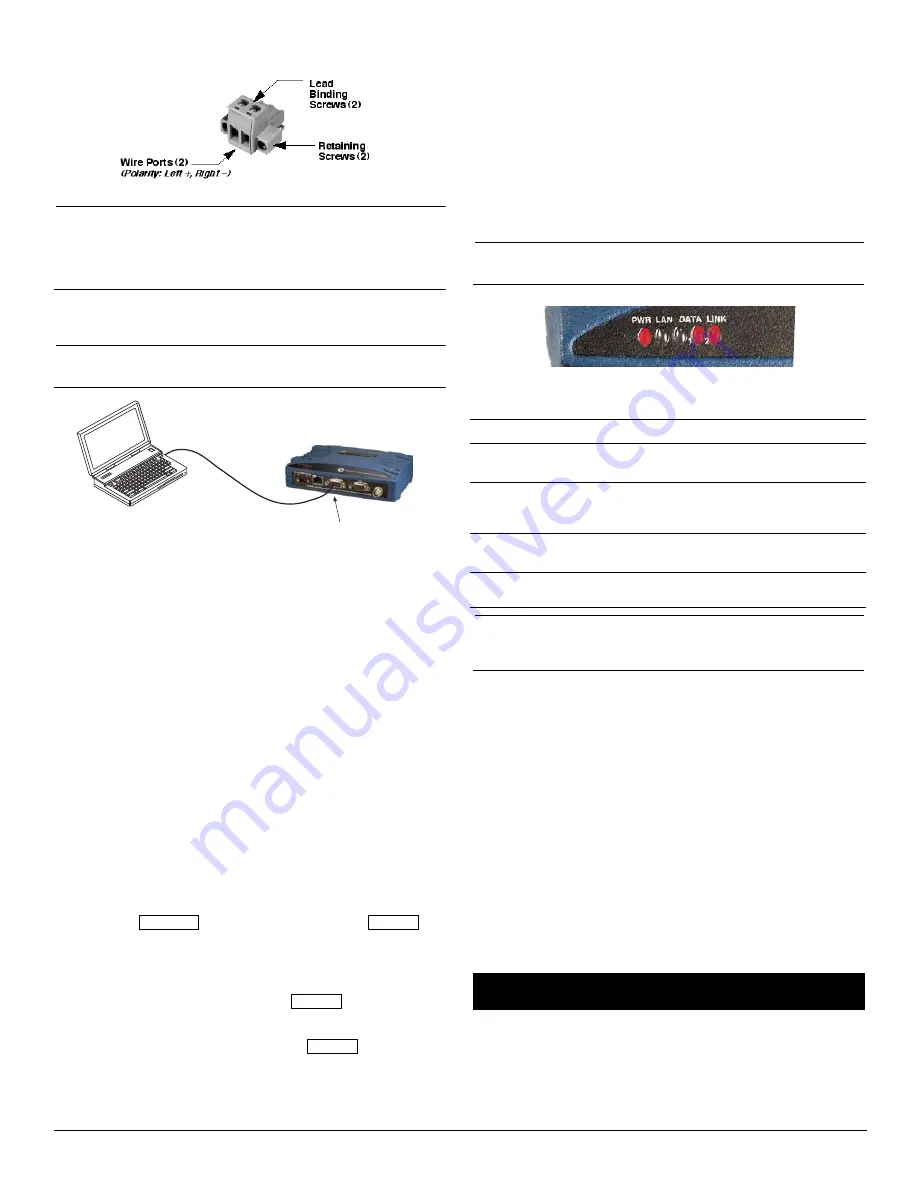
2
MDS SD Series Quick Start Guide (x710 Mode)
05-6358A01, Rev. 02 (FCC)
Figure 4
). Strip the wire leads to 6 mm (1/4 inch) and insert
them into the wire ports. Be sure to observe proper polarity as
shown below. Tighten the binding screws securely.
Figure 4. DC Power Connector
CAUTION:
The unit is designed for use with
negative-ground
systems only. The power supply should be equipped
with overload protection (NEC Class 2 rating), to
protect against a short circuit between its output termi-
nals and the radio’s power connector.
5.
Set the radio’s configuration.
Connect a PC to the radio’s
COM1 port as shown in
Figure 5
. A straight-thru cable may be
used for this connection.
NOTE:
Consult your System Administrator if you are unsure of
the settings required for your network.
Figure 5. Setup for PC Configuration
2.1.1
Software Configuration
There are two methods for communicating with the radio for con-
figuration and management:
Serial
(COM1 DB9 connector) and
Telnet
(ETHERNET RJ-45 connector). Both present identical
functionality, but the method of access is different for each. The
focus here is on Serial access, but Telnet may be used by following
these additional points, which replace Steps 1 and 2 below:
• For Telnet, connect to the radio with a PC that is on the
same IP network as the transceiver. Launch a Telnet pro-
gram, and connect to the radio using its programmed IP
address.
• The default IP address is 192.168.1.1. If you do not know the
IP address of the radio, use the serial configuration steps
below to view the address with the
IPCONFIG
command.
1. With a PC connected to the COM1 serial port, launch a
terminal program, such as HyperTerminal (included with most
pre-Vista Windows®-based PCs) and set the following
parameters:
8 bits, no parity, one stop bit (8N1), flow control disabled,
VT100 emulation
. The radio’s COM1 port automatically
determines the connected baud rate (within the range of
1200–115200 bps).
2. Press the
key followed by a series of
keypresses (1/2 second intervals) until the
>
prompt appears.
The radio is now ready to accept commands.
3. Set/verify the
RX
(receive) and
TX
(transmit) frequencies. To
set the receive frequency, enter
RX
followed by the correct fre-
quency in MHz (
xxx.xxxxx
). Press
.
To set the transmit frequency, enter
TX
followed by the correct
frequency in MHz (
xxx.xxxxx
). Press
.
4. The factory default modem settings support operation for most
systems. Other options are available using the proper soft-
ware commands. The current setting may be viewed using the
MODEM
command. Use
MODEM [xxxx]
if changes are
required, where xxxx represents the modem speed in bps.
When finished with the steps above, review the other configu-
ration options to determine if other settings are required for
your system.
Table 3
lists key software commands for the
radio.
2.2
Initial Checkout
In-service operation of the transceiver is completely automatic.
The only operator actions required are to apply DC power and
observe the LEDS for proper indications.
Table 1
summarizes the
radio’s LED functions.
2.2.1
LED Functions
NOTE:
LED labeling may vary on early units. LED position and
functionality remains as described below.
Figure 6. LED Status Indicators
Table 1: Description of LED Status Indicators
NOTE:
The Ethernet connector also has two embedded LEDs. A
flashing green indicates Ethernet data activity, and a
yellow indicates 100 Mbps operation has been achieved.
2.2.2
Antenna SWR Check
Before placing the unit in final operation, the antenna system’s
standing wave ratio (SWR) should be checked using a wattmeter
suited to the frequency of operation. High SWR (above 2:1) may
indicate an antenna or feedline problem, and should be corrected.
2.2.3
RSSI Check (for Remotes)
Using the
RSSI
command (received signal strength indication),
check for adequate signal strength. The radio must be receiving a
signal from the associated Master Station (LINK LED on or
blinking). In general, signal levels stronger than –80 dBm will pro-
vide very reliable communication and allow for a degree of “fade
margin.”
Optimize the RSSI at Remotes by slowly adjusting the direction of
the station antenna. Watch the RSSI indication for several seconds
after making each adjustment so that the RSSI accurately reflects
any change in the signal strength. With RSSI, the less negative the
number, the stronger the incoming signal (
i.e.,
-70 dBm is stronger
than -80 dBm).
All radios in the network must meet the following basic require-
ments for proper operation. Check these items first when trouble-
shooting a communication problem:
• Adequate and stable primary power
• Secure cable connections (RF, data and power)
• A clear transmission path between Master and each Remote
PC Running Terminal Session
Transceiver
DB-9M to COM1 Port
ESCAPE
ENTER
ENTER
ENTER
LED Name
Description
PWR
• Continuous—Power applied, no problems detected.
• Rapid flash (5x-per-second)—Alarm indication.
LAN
• Flashing—Ethernet data activity is detected.
• Off—Ethernet signals not detected, or excessive
traffic is present at the port.
DATA1/DATA2
These LEDs show data activity on the DB-9 serial
payload port(s).
LINK
When lit, indicates that a communication link exists
with the master station.
3.0
TROUBLESHOOTING





